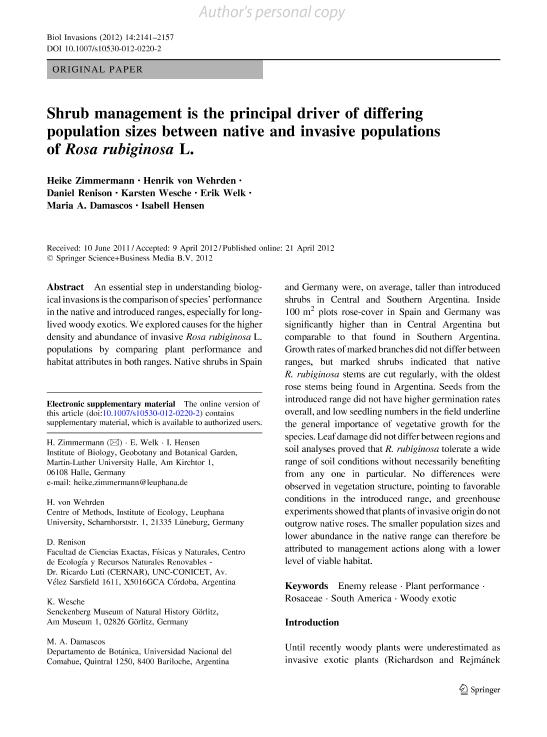Mostrar el registro sencillo del ítem
dc.contributor.author
Zimmermann, Heike
dc.contributor.author
von Wehrden, Henrik
dc.contributor.author
Renison, Daniel

dc.contributor.author
Wesche, Karste
dc.contributor.author
Welk, Erik
dc.contributor.author
Damascos, Maria Angélica

dc.contributor.author
Hensen, Isabell
dc.date.available
2018-04-19T14:36:10Z
dc.date.issued
2012-10
dc.identifier.citation
Zimmermann, Heike; von Wehrden, Henrik; Renison, Daniel; Wesche, Karste; Welk, Erik; et al.; Shrub management is the principal driver of differing population sizes between native and invasive populations of Rosa rubiginosa L.; Springer Verlag Berlín; Biological Invasions; 14; 10; 10-2012; 2141-2157
dc.identifier.issn
1387-3547
dc.identifier.uri
http://hdl.handle.net/11336/42640
dc.description.abstract
An essential step in understanding biological invasions is the comparison of species' performance in the native and introduced ranges, especially for long lived woody exotics. We explored causes for the higher density and abundance of invasive Rosa rubiginosa L. populations by comparing plant performance and habitat attributes in both ranges. Native shrubs in Spain and Germany were, on average, taller than introduced shrubs in Central and Southern Argentina. Inside 100 m2 plots rose-cover in Spain and Germany was significantly higher than in Central Argentina but comparable to that found in Southern Argentina. Growth rates of marked branches did not differ between ranges, but marked shrubs indicated that native R. rubiginosa stems are cut regularly, with the oldest rose stems being found in Argentina. Seeds from the introduced range did not have higher germination rates overall, and low seedling numbers in the field underline the general importance of vegetative growth for the species. Leaf damage did not differ between regions and soil analyses proved that R. rubiginosa tolerate a wide range of soil conditions without necessarily benefiting from any one in particular. No differences were observed in vegetation structure, pointing to favorable conditions in the introduced range, and greenhouse experiments showed that plants of invasive origin do not outgrow native roses. The smaller population sizes and lower abundance in the native range can therefore be attributed to management actions along with a lower level of viable habitat.
dc.format
application/pdf
dc.language.iso
eng
dc.publisher
Springer Verlag Berlín

dc.rights
info:eu-repo/semantics/openAccess
dc.rights.uri
https://creativecommons.org/licenses/by-nc-sa/2.5/ar/
dc.subject
Enemy Release
dc.subject
Plant Performance
dc.subject
Rosaceae
dc.subject
South America
dc.subject
Woody Exotic
dc.subject.classification
Otras Ciencias Biológicas

dc.subject.classification
Ciencias Biológicas

dc.subject.classification
CIENCIAS NATURALES Y EXACTAS

dc.title
Shrub management is the principal driver of differing population sizes between native and invasive populations of Rosa rubiginosa L.
dc.type
info:eu-repo/semantics/article
dc.type
info:ar-repo/semantics/artículo
dc.type
info:eu-repo/semantics/publishedVersion
dc.date.updated
2018-04-10T14:04:55Z
dc.identifier.eissn
1573-1464
dc.journal.volume
14
dc.journal.number
10
dc.journal.pagination
2141-2157
dc.journal.pais
Alemania

dc.journal.ciudad
Berlin
dc.description.fil
Fil: Zimmermann, Heike. Martin-Luther University Halle, Geobotany and Botanical Garden, Institute of Biology; Alemania
dc.description.fil
Fil: von Wehrden, Henrik. Leuphana University, Centre of Methods, Institute of Ecology; Alemania
dc.description.fil
Fil: Renison, Daniel. Consejo Nacional de Investigaciones Científicas y Técnicas. Centro Científico Tecnológico Conicet - Córdoba. Instituto de Investigaciones Biológicas y Tecnológicas. Universidad Nacional de Córdoba. Facultad de Ciencias Exactas, Físicas y Naturales. Instituto de Investigaciones Biológicas y Tecnológicas; Argentina
dc.description.fil
Fil: Wesche, Karste. Senckenberg Museum of Natural History Görlitz; Alemania
dc.description.fil
Fil: Welk, Erik. Martin-Luther University Halle, Geobotany and Botanical Garden, Institute of Biology; Alemania
dc.description.fil
Fil: Damascos, Maria Angélica. Universidad Nacional del Comahue; Argentina
dc.description.fil
Fil: Hensen, Isabell. Martin-Luther University Halle, Geobotany and Botanical Garden, Institute of Biology; Alemania
dc.journal.title
Biological Invasions

dc.relation.alternativeid
info:eu-repo/semantics/altIdentifier/url/https://link.springer.com/article/10.1007%2Fs10530-012-0220-2
dc.relation.alternativeid
info:eu-repo/semantics/altIdentifier/doi/http://dx.doi.org/10.1007/s10530-012-0220-2
Archivos asociados
